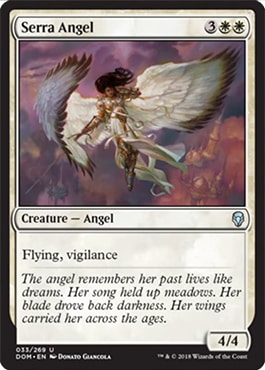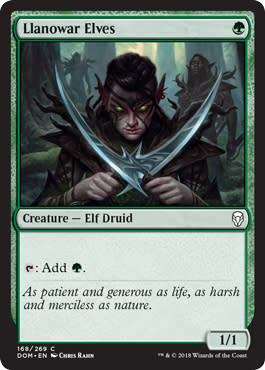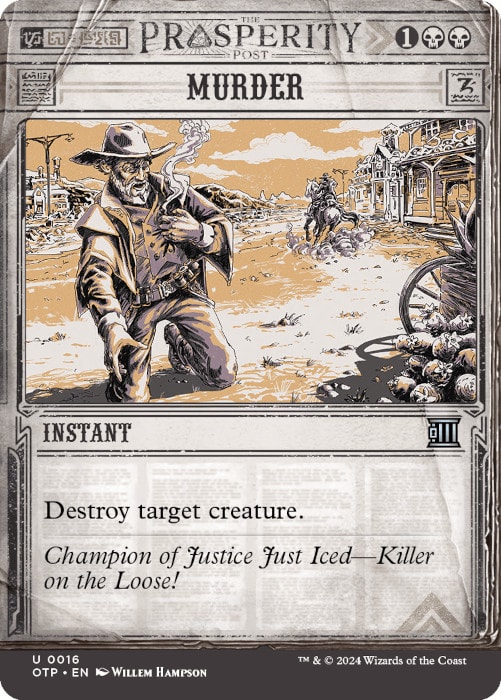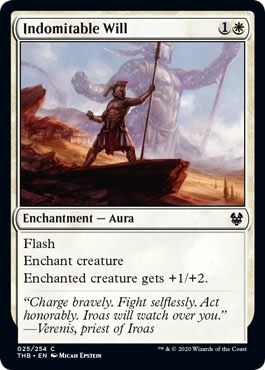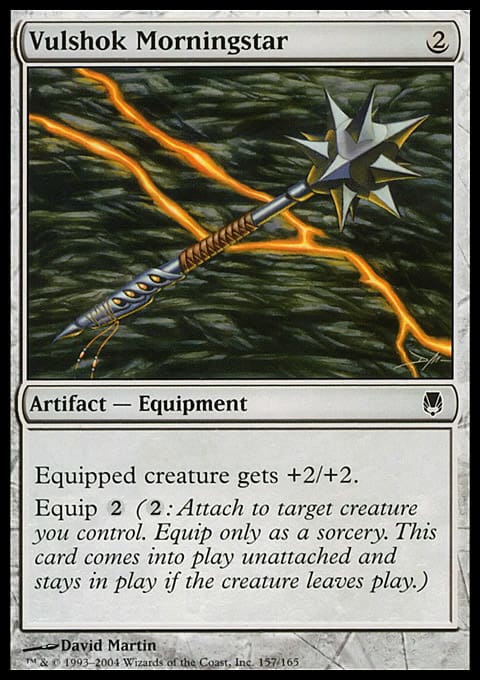Getting into Magic: The Gathering these days can be tough. While Magic at its core has simple game concepts to understand, it can be easy to get bogged down in a swath of various cards, formats, and gameplay strategies. When you first start playing it's important to learn some basics of gameplay, such as how to take your turn, basic combat, and how to cast spells.
As someone who's played Magic for over a decade, both casually and competitively, here are ten cards that I believe are some of the easiest and important to learn for beginners!
1. Serra Angel
Serra Angel is one of, if not the most, iconic creature in MTG. Featured in MTG's inaugural set, Alpha, Serra Angel is a 4/4 flying, vigilance creature for ![]()
![]()
![]() mana. Serra Angel acts as a creature that can totally warp combat in a given game, given that it has evasion in flying, and doesn't have to tap to attack in vigilance. 4 power means that attacking with a Serra Angel five times unchecked will mean victory. Serra Angel is Magic's most iconic angel, and a masterclass in designing a creature threat that can dominate any board it gets cast onto.
mana. Serra Angel acts as a creature that can totally warp combat in a given game, given that it has evasion in flying, and doesn't have to tap to attack in vigilance. 4 power means that attacking with a Serra Angel five times unchecked will mean victory. Serra Angel is Magic's most iconic angel, and a masterclass in designing a creature threat that can dominate any board it gets cast onto.
2. Lightning Bolt
Another iconic Magic card for beginners, and certainly Red's most iconic card, is Lightning Bolt. As a lover of Burn decks, Lightning Bolt can teach some very important lessons in understanding a game of Magic. First of all, Lightning Bolt can target anything you wish. You can point it at your opponent's 3/3 creature, but you also have the option of just impacting their life total for three damage. However, three damage is only 15% of your opponent's life total, meaning that to win the game you'll have to damage them in other ways in addition to your Lightning Bolt. What's so incredibly powerful about a card like Lightning Bolt is its flexibility. Your opponent may have more cards in hand, or a swath of creatures at their disposal, but if they're at three life when you draw a Lightning Bolt - well that's light's out. Lightning Bolt is a card that demands to be played around. You can't take enough damage to wind up at three life if you know your opponent has Lightning Bolt in their deck.
3. Llanowar Elves
Llanowar Elves is another essential Magic card to learn, and a centerpiece of how Green decks take advantage of their resources. If you play a Llanowar Elves on turn one of the game, you've completely altered the tempo of the game itself. What I mean by this is as soon as this little 1/1 elf hits the battlefield, your opponent is now under pressure to act fast. By having Llanowar Elves in play, you have another mana resource, akin to having an extra Forest in play. Equally important to having Llanowar Elves in play is how to best abuse it. If your opening hand is all lands and Llanowar Elves, then your hand is essentially all mana and there aren't impactful plays you can make. However, if you play a turn one Llanowar Elves and follow it up with a three-mana creature on turn two rather than turn three, you now present a threat that's larger than what your opponent can play on their turn two, thus altering the tempo of the game.
4. Murder
A cornerstone of Black cards, Murder falls into a category of spell called a "removal" spell. As the name implies it's a card that can essentially destroy any creature you want it to. Removal spells, such as Murder, help balance out creatures. You can use a Murder to clear away your opponent's only blocker to attack them for lethal, for example. By using Murder, which only costs three mana, to kill a creature that's three mana or greater, you're essentially gaining an advantage by using less resources to remove something your opponent spent more resources on. Murder shines in cases where it essentially can trade for two of your opponent's cards. For example, if your opponent uses an instant spell to give their creature +4/+4 in response to you blocking that creature with your own, Murder can destroy that creature before the opponent's spell would give it +4/+4. In this case, you used one card to remove two of your opponent's.
5. Inspiration
Drawing cards and using Instants is at the heart of Blue's design. When you first learn to play MTG, on average you're learning how to untap, draw a card for turn, cast a spell, maybe attack, and then pass. You get used to learning how to cast spells during your turn, primarily creatures. However, Inspiration is an easy Blue card to learn that teaches a few key lessons. Inspiration shows players how they can cast spells at instant-speed, but more importantly how to turn one card into two. On turn four you can cast Inspiration on your opponent's turn to draw two cards. First you get to have mana untapped during the opponent's turn to represent any number of Instants. Second, if you draw two good spells off Inspiration, you've successfully turned one card into two. Even if you draw two land cards off Inspiration, those would've been two lands you were going to draw during your next two draw steps anyway. Card draw can help you hit your land drops, find more action, and essentially have more tools at your disposal than your opponent if you're drawing more cards than them.
6. Indomitable Will
While Indomitable Will looks simple on the surface, it has a pretty in-depth design. Indomitable Will having Flash makes it a combat trick that White can use. You can utilize this card during combat to make your attacker or blocker slightly larger than your opponent's, but rightfully so that it won't be destroyed in combat. Being an Aura Enchantment, Indomitable Will gets to stick around on the battlefield! This means that unlike other combat tricks that are Instants, you'll get the +1/+2 bonus for as long as that enchanted creature stays in play. Indomitable Will teaches how White can use spells to rescue their creatures from dire circumstances. It also teaches players what an enchantment is, specifically an aura in this case.
7. Vulshok Morningstar
Artifacts are one of the basic types of Magic cards. They're colorless, meaning they have no color, and they're usually treated as cards that have some sort of baked-in benefit that stick around on the battlefield. In this case, Vulshok Morningstar is an Equipment Artifact, similar to an aura like Indomitable Will, but the difference being you can move it around between your creatures. Vulshok Morningstar, for a mana investment of ![]() (
(![]() to cast it,
to cast it, ![]() to equip) lets you permanently grow your creature by +2/+2. What's so impactful about a card like this, is that it sticks around on the battlefield, even if the creature it was initially equipped to gets destroyed in some fashion. You can make your 2/2 a 4/4, meaning that if your opponent wants to destroy it in combat they might have to block with their 4/4 or even two 2/2s. Equipment cards like this that can boost a creature's power and toughness make combat more difficult for your opponent, as you can keep growing and moving around this +2/+2 buff across your creatures.
to equip) lets you permanently grow your creature by +2/+2. What's so impactful about a card like this, is that it sticks around on the battlefield, even if the creature it was initially equipped to gets destroyed in some fashion. You can make your 2/2 a 4/4, meaning that if your opponent wants to destroy it in combat they might have to block with their 4/4 or even two 2/2s. Equipment cards like this that can boost a creature's power and toughness make combat more difficult for your opponent, as you can keep growing and moving around this +2/+2 buff across your creatures.
8. Mammoth Spider
Remember that card Serra Angel I mentioned a little while ago? Meet its worst enemy - Mammoth Spider. Mammoth Spider is a creature that not only has the keyword Reach, letting it block creatures with Flying, it also has more toughness than it has power. Why is that important, you might ask? The answer is it makes for a good blocker. While learning how to turn your creatures sideways to attack your opponent is a MTG basic, equally as important is learning how to block. Mammoth Spider presents a card that has high toughness, and even though it has 3 power, it can block a 4/4 creature with ease. Here's an even better example. Say your opponent has a 7/7 creature and you have a Mammoth Spider and a 4/4 creature in play. If they attack with the 7/7 creature you can block with Mammoth Spider and the 4/4. They can only destroy one of your creatures, and more importantly, you get to destroy their 7/7! After the dust has settled you'll end up trading either your Mammoth Spider or your 4/4 for their beefy 7/7! This is what we call "trading up" - in this scenario you've traded a worse creature on your side of the battlefield for a much better creature on your opponent's side.
9. Evolving Wilds
While most Magic players start out learning the five basic land types, Evolving Wilds provides a unique perspective on how to build decks. Evolving Wilds introduces the concept of playing more than one color, allowing players to mix and match between the five colors into playing two or even more colors in a single deck. If you're playing a deck with Red and Black cards in it, you will have some split of Mountains and Swamps for your lands. However, Evolving Wilds acts as a way where you can have the choice of whatever basic land you need. If you have an opening hand with all Red cards and Swamps, it's not a keepable hand because you can't cast any of your spells - you unfortunately did not draw any Mountains to balance out your Swamps. However if you have the exact same hands, but one or more lands are Evolving Wilds, you now have the ability to cast your Red cards, even though your hand has no physical Mountains in it. Evolving Wilds is an easy to understand card that can teach players the basics of playing more than one color in their deck.
10. Cackling Fiend
Something I mentioned earlier when talking about the card Murder was the idea of a two-for-one - a way you can use one card to trade for two of your opponent's. While attacking and blocking are easy lessons to learn in MTG, one basic lesson that should be instilled early on is how are you going to beat your opponent and run them out of resources? A lot of games of Magic end up with the winner having won the resource war, basically having them make the most out of their cards. Cackling Fiend is an easy to understand example of how to turn one card into two. What I mean by this is when Cackling Fiend comes into play, it'll have your opponent discard a card. Later on, if Cackling Fiend trades off with your opponent's 2/2, or maybe it blocks with another creature to destroy a bigger creature in combat, it's now traded for two cards in total - the one it initially made your opponent discard, and one that was in play. Cackling Fiend is a basic example of more complicated cards that exist in MTG and are popularly played. At its best, Cackling Fiend will have your opponent discard a powerful spell, maybe even the last card in their hand they were saving for the next turn, and provide a creature that you can use in other ways as a resource.
With Magic being over thirty years old there are tons of cards to learn and understand. With the advent of double-faced cards and multiple unique mechanics appearing in each new expansion, it can be hard to keep up with how the game is ever-changing. I hope this article gives you some insight into learning some of the basic cards of the game, and how understanding their design and utility can help you better shape your gameplay.
Thanks for reading!
-Roman Fusco














